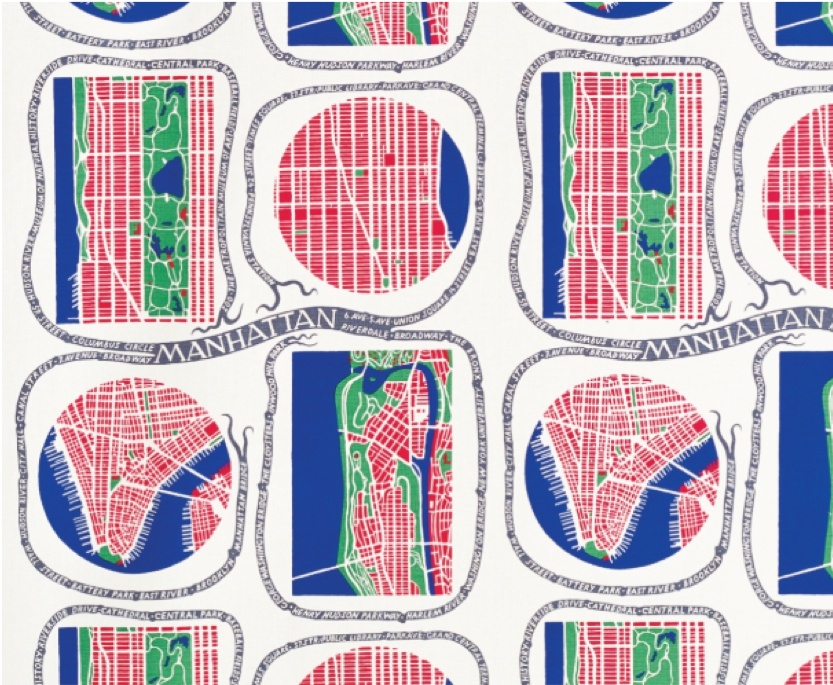In its recent judgment of 14 March in case C-21/18, the Court of Justice of the European Union (“CJEU”) has ruled about the notion of “shape” contained in the absolute ground for refusal stated in article 7.1 e) paragraph iii) of the European Union Trademark Regulation.
Such interpretation has taken place when solving a request for a preliminary ruling made by the Patent and Commercial Chamber of the Stockholm Court of Appeal in the context of a dispute between the company Textilis Ltd and Mr Ozgur Kesking on the one hand, and Svenskt Tenn Ab, on the other hand.
As a result of a collaboration between Svenskt Tenn and the architect Josef Frank in the 1930s, several fabric patterns were created, among them one in particular named “MANHATTAN”, with which the Swedish company marketed textiles and other household items and which was registered by this company in 2012 as a European Union figurative trademark in relation to products and services of the classes 11, 16, 20, 21, 24, 27 and 35.
The graphic representation of the said trademark is the following:

The English company Textilis, owned by Mr. Keskin, marketed fabrics and interior decoration products bearing patterns similar to those of the figurative mark MANHATTAN. This led the Swedish merchant to start in Sweden, against Textilis and Mr. Keskin, a proceeding based on trademark infringement and violation of their intellectual property rights on the particular pattern, in which, by way of counterclaim, it was requested the nullity of the MANHATTAN trademark, based on lack of distinctiveness and in the prohibition of article 7.1 letter e, subparagraph iii) of the EU Trademark Regulation. The defendants understood that having regard to the way in which the trademark was used, it would be made up of a shape which gives substantial value to the goods.
The claim of Svenskt Tenn was upheld in the first instance and was during the appeal proceeding, when the Patent and Commercial Chamber of the Court of Appeal of Stockholm, decided to submit a preliminary ruling to the CJEU, in which, in summary, it questioned:
1º. If article 7.1, letter e, paragraph iii) in its version amended by Regulation 2015/2424), under which registration is refused not only for signs which consist exclusively of ‘the shape’, but also ‘another characteristic of the goods’, which gives substantial value to it, is capable of altering the assessment to be made by virtue of that ground for invalidity and if it is applicable to trademarks registered before this amendment entered into force.
2º. If such prohibition, in the version before the amendment of the Regulation, is applicable to sign which consists of the two-dimensional representation of a two-dimensional product, for example fabric decorated with the sign in question.
3º. What principles govern the interpretation of the wording ‘signs which consist exclusively of the shape (or another characteristic) which gives substantial value to the goods’, used in the version of the Article 7(1)(e)(iii) after the amendment of the EU trademark Regulation, where the registration covers a wide range of classes of goods and the sign may be affixed in different ways to the goods.
In response to these questions, the CJEU states the following:
First, it considers that it is not apparent from either the purpose or the scheme of Regulation 2015/2424 that the EU legislature intended to confer retroactive effect to Article 7(1)(e)(iii). Therefore, the amended version of this provision does not apply to trademarks that were registered before it entered into force.
Second, it considers that in accordance with the concept of “shape”, determined by its usual meaning in everyday language and about which the CJEU already ruled in its famous judgment of 12 June 2018 in case C-163/16, relating to the red sole of Louboutin’s shoes, (understood as a set of lines or contours that outline the product concerned), the contested sign cannot be regarded as consisting exclusively of the shape of the product, since despite the sign under consideration represents shapes which are formed by the external outline of drawings representing geographical maps, the fact remains that, apart from those shapes, that sign contains decorative elements which are situated both inside and outside those outlines, such as the word “MANHATTAN”. In other words, although the sign is formed by two-dimensional decorative motifs that are affixed to the products, these can be distinguished from the shape of the product and, as a consequence, the exclusion laid down Article 7(1)(e)(iii), in its version prior to the amendment by Regulation 2015/2424 cannot apply to it.
In view of the answer given by the Court to the second question, it considers that it is not necessary to reply to the third question.
Although this ruling clarifies the concept of "shape" contained in the prohibition of Article 7.1 letter e), subsection iii), according to the version of Regulation 207/2009, since it does not provide a response to the third question referred, unfortunately it does not shed light on the principles according to which the terms of the new wording given to this article by the amending Regulation 2015/2424, "signs which consist exclusively of the shape, or another characteristic, which gives substantial value to the goods" should be interpreted; which would have clarified many doubts about the possible new scope of this prohibition.
